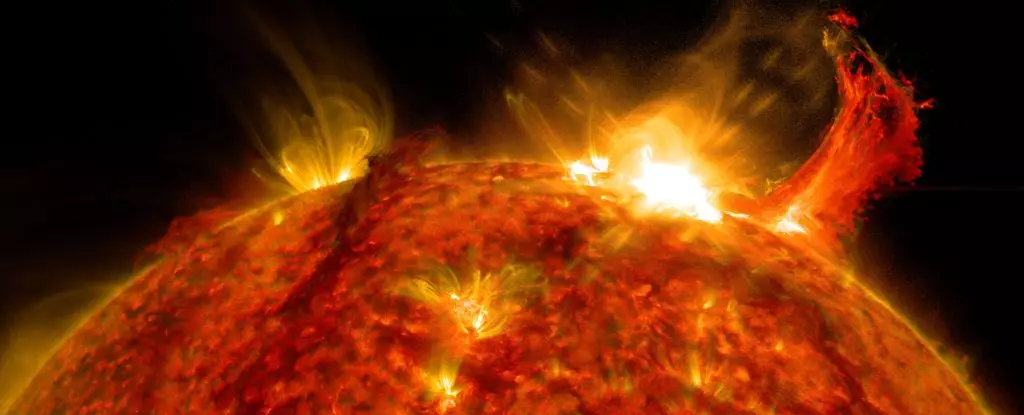Around 14,300 years ago, a staggering cosmic event unleashed a torrent of solar energy that fundamentally impacted our planet. This incident, which occurred in approximately 12,350 BCE, marks a pivotal moment in Earth’s history, revealing the immense forces that the Sun can exert upon our planet. Recent advances in climate-chemistry modeling, particularly through a groundbreaking tool named SOCOL:14C-Ex, have provided scientific revelations that comprehend the full magnitude of this ancient solar storm, creating a new reference point in our understanding of celestial influences on Earth.
This event elicits an intense curiosity about the Sun’s behavior, significantly as it surpassed previous estimations of solar activity. While we have snapshots of geomagnetic storms, such as the infamous Carrington Event of 1859, the intensity of the 12,350 BCE solar event provides a shocking contrast. The fact that it was inferred to be over 500 times more intense than modern scenarios, such as the 2005 particle storm, is an eye-opener that challenges preconceived notions about solar activity.
The Mechanics of Cosmic Interference
At the heart of this intrigue lies the geomagnetic storm, a phenomenon usually triggered by coronal mass ejections—massive bursts of solar plasma, replete with magnetic fields. When these high-energy particles collide with Earth’s atmosphere, they create an array of effects, from breathtaking auroras to potentially catastrophic technological malfunctions. The Carrington Event, which caused widespread disruptions to telegraphic communication, serves as a testament to the chaotic interplay between solar eruptions and our technological infrastructure. The 1989 solar storm that led to power outages in Quebec further exemplifies the real-world implications that such events can have in the modern era.
Interestingly, one key aspect of geomagnetic activity is its ability to augment the presence of carbon-14, a radioactive carbon isotope formed when cosmic particles interact with atmospheric components. This phenomenon serves as a timekeeper; by examining carbon-14 spikes in ancient tree rings and other organic materials, scientists can draw parallels to historical solar events. The 2023 analysis of this ancient solar storm serves as an acknowledgment of the interwoven relationship between celestial events and life on Earth.
A Breakthrough in Climate-Chemistry Modeling
The rigor of scientific inquiry brought forth by researchers in this field has been commendable. The introduction of the SOCOL:14C-Ex model represents a significant leap in understanding historical solar phenomena. Historically, models developed to analyze radiocarbon data were largely confined to the Holocene epoch—a relatively stable climatic period spanning the last 12,000 years. The endeavor to extend this analysis to pre-Holocene events, particularly those occurring during harsher glacial climates, demonstrates an innovative approach to historical climatic events.
The research team, guided by space physicist Kseniia Golubenko from the University of Oulu, conducted an in-depth analysis of the data from 12,350 BCE. By validating their model against the known solar event of 774 CE, they confirmed its efficacy, allowing them to confidently probe into one of the most intense solar storms ever recorded. The revelations of their research not only highlight the significance of the ancient event but also establish a new benchmark for worst-case scenarios related to solar activity.
The Implications of Solar Events on Life and Technology
The findings raise compelling questions about the impact of such extraordinary solar activity on the ancient ecosystems and human civilizations. With the Earth’s natural environment being delicately balanced, the consequences of a celestial onslaught could have been catastrophic. Though humans during the Pleistocene epoch faced threats primarily from climactic and ecological changes, the increased levels of carbon-14 could signify either adaptation to or disruption of various living organisms.
In an age where technology governs our lives, understanding the potential ramifications of geomagnetic storms is crucial. With our reliance on satellites and electronic grids, even a fraction of the intensity observed in 12,350 BCE could wreak havoc on global networks. The ensuing discussions within the scientific community about preparedness and resilience in the face of such solar events has never been more relevant, pointing to the urgent need for robust monitoring and necessary preventative measures.
As we draw upon knowledge from the past, the cosmos offers lessons packed with both wonder and caution. The astounding event of 12,350 BCE not only illuminates our understanding of solar behavior but also challenges us to contemplate the vulnerabilities of our contemporary existence amid celestial forces beyond our control.


Leave a Reply